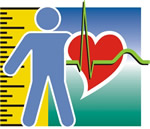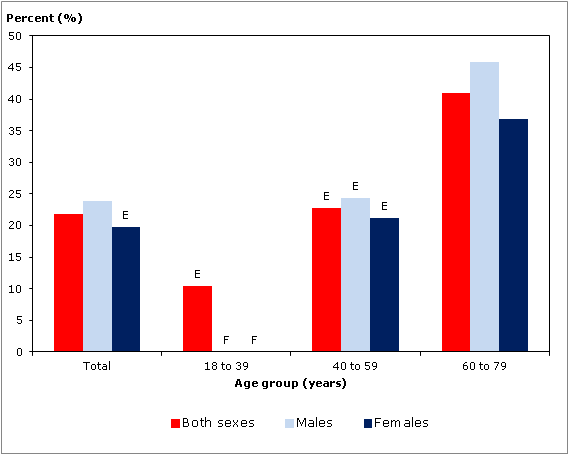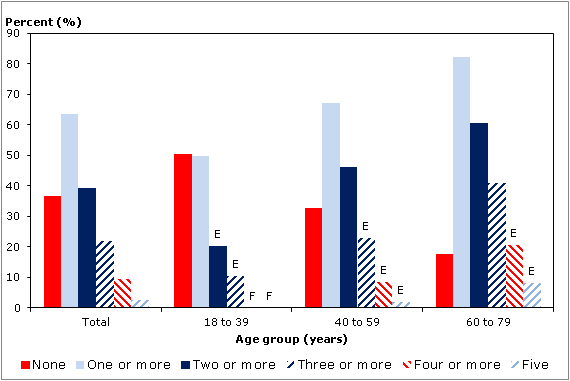Metabolic syndrome in Canadians, 2009 to 2011
Archived Content
Information identified as archived is provided for reference, research or recordkeeping purposes. It is not subject to the Government of Canada Web Standards and has not been altered or updated since it was archived. Please "contact us" to request a format other than those available.

Results from the 2009 to 2011 Canadian Health Measures Survey (CHMS) indicate that 1 in 5 Canadian adults aged 18 to 79 had metabolic syndrome.
Metabolic syndrome is a clustering of risk factors that increase a person's risk of cardiovascular disease and type 2 diabetes.1 These risk factors include abdominal obesity (high waist circumference), elevated triglycerides, low high-density lipoprotein (HDL), high fasting blood glucose, and high blood pressure.1
Metabolic syndrome was found in 22% of Canadians aged 18 to 79 years (Chart 1). The prevalence of metabolic syndrome increases significantly with age such that only 1 in 10 Canadians aged 18 to 39 years were found to have metabolic syndrome compared to 4 in 10 Canadians aged 60 to 79 years. There were no significant differences found between males and females.
Chart 1
Metabolic syndrome†, by age group and sex, household population aged 18 to 79, Canada, 2009 to 2011

E Use with caution (data with a coefficient of variation (CV) from 16.6% to 33.3%)
F Too unreliable to be published (data with a coefficient of variation (CV) greater than 33.3%; suppressed due to extreme sampling variability)
† According to new Harmonized Metabolic Syndrome definition1
Source: Canadian Health Measures Survey, 2009 to 2011. The CHMS collects health information on the Canadian household population aged 3 to 79.
Though only 22% of Canadian adults were determined to have metabolic syndrome based on having three or more component risk factors, 39% had two or more components, 64% had at least one, and only 37% had none at all (Chart 2). The number of metabolic syndrome risk factors increased significantly with age: approximately 5 in 10 adults aged 18 to 39 had at least one risk factor, compared to approximately 8 in 10 adults aged 60 to 79. Similarly, 2 in 10 adults aged 18 to 39 had at least 2 risk factors, compared to 6 in 10 adults aged 60 to 79. There were no significant differences in the number of component risk factors between males and females.
Chart 2
Proportion of the population by number of metabolic syndrome components, by age, household population 18 to 79, Canada, 2009 to 2011

E Use with caution (data with a coefficient of variation (CV) from 16.6% to 33.3%)
F Too unreliable to be published (data with a coefficient of variation (CV) greater than 33.3%; suppressed due to extreme sampling variability)
† According to new Harmonized Metabolic Syndrome definition1
Source: Canadian Health Measures Survey, 2009 to 2011. The CHMS collects health information on the Canadian household population aged 3 to 79.
About metabolic syndrome
Metabolic syndrome was determined according to recent unified criteria.1 Under these criteria, metabolic syndrome is present if any three of the following criteria are met:
| Criterion | Cut-off for males | Cut-off for females |
|---|---|---|
| Abdominal obesity | Waist circumference ≥102 cm | Waist circumference ≥88 cm |
| Elevated plasma triglycerides | ≥1.7 mmol/L | ≥1.7 mmol/L |
| Elevated fasting blood glucose | ≥5.6 mmol/L | ≥5.6 mmol/L |
| Decreased HDL cholesterol | <1.03 mmol/L | <1.30 mmol/L |
| Elevated blood pressure | ≥130/85 mmHg | ≥130/85 mmHg |
| HDL = high density lipoprotein | ||
Additionally, the use of any medication for any of the above criteria is considered as meeting that specific criterion.
References
- Alberti K, Eckel RH, Grundy SM, et al. Harmonizing the metabolic syndrome. A joint interim statement of the International Diabetes Federation Task Force on Epidemiology and Prevention; National Heart, Lung, and Blood Institute; American Heart Association; World Heart Federation; International Atherosclerosis Society; and International Association for the Study of Obesity. Circulation. 2009;120(16):1640-5.
For more information on the Canadian Health Measures Survey, please contact Statistics Canada's National Contact Centre (toll-free 1-800-263-1136; 613-951-8116; infostats@statcan.gc.ca).
- Date modified:
